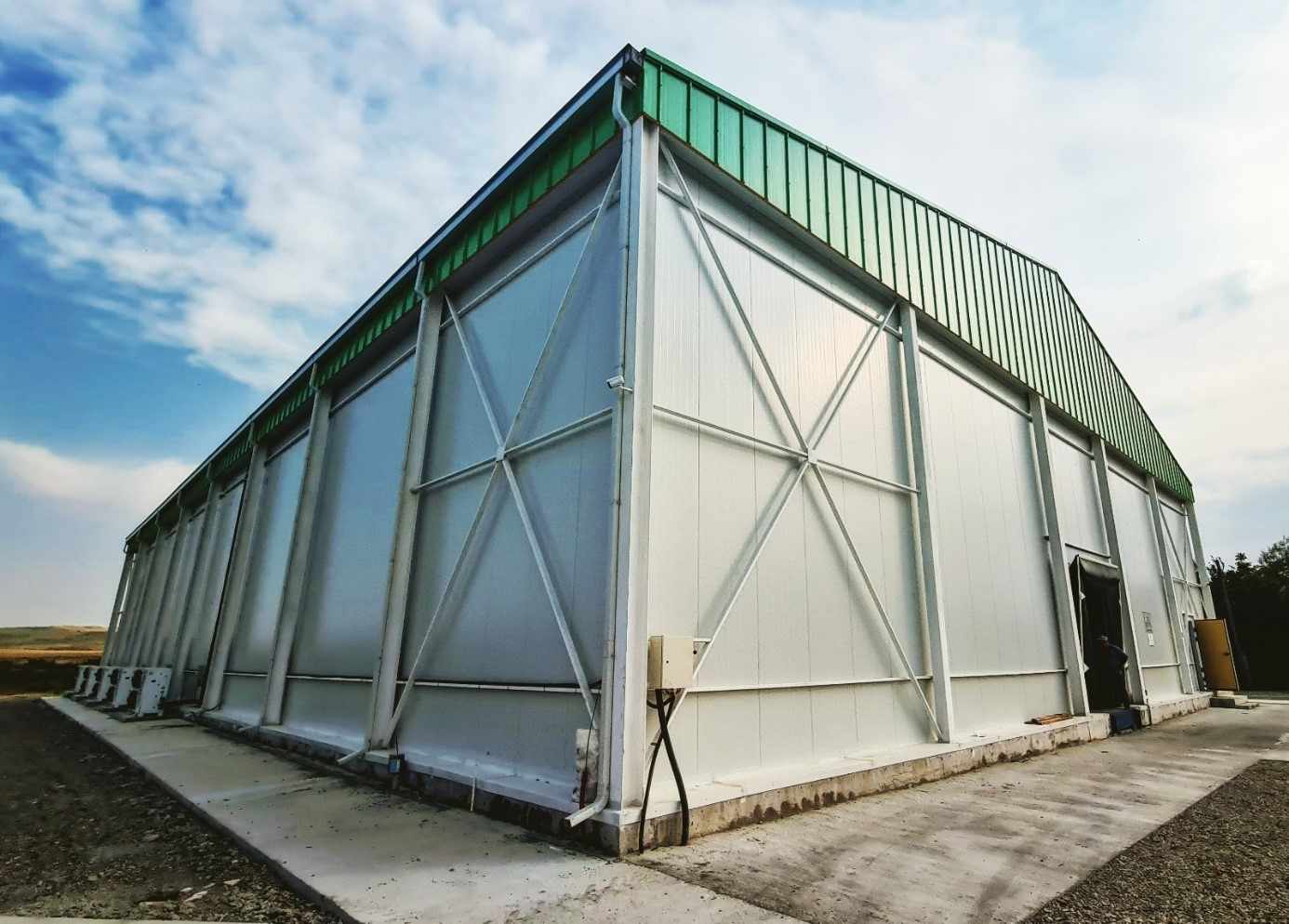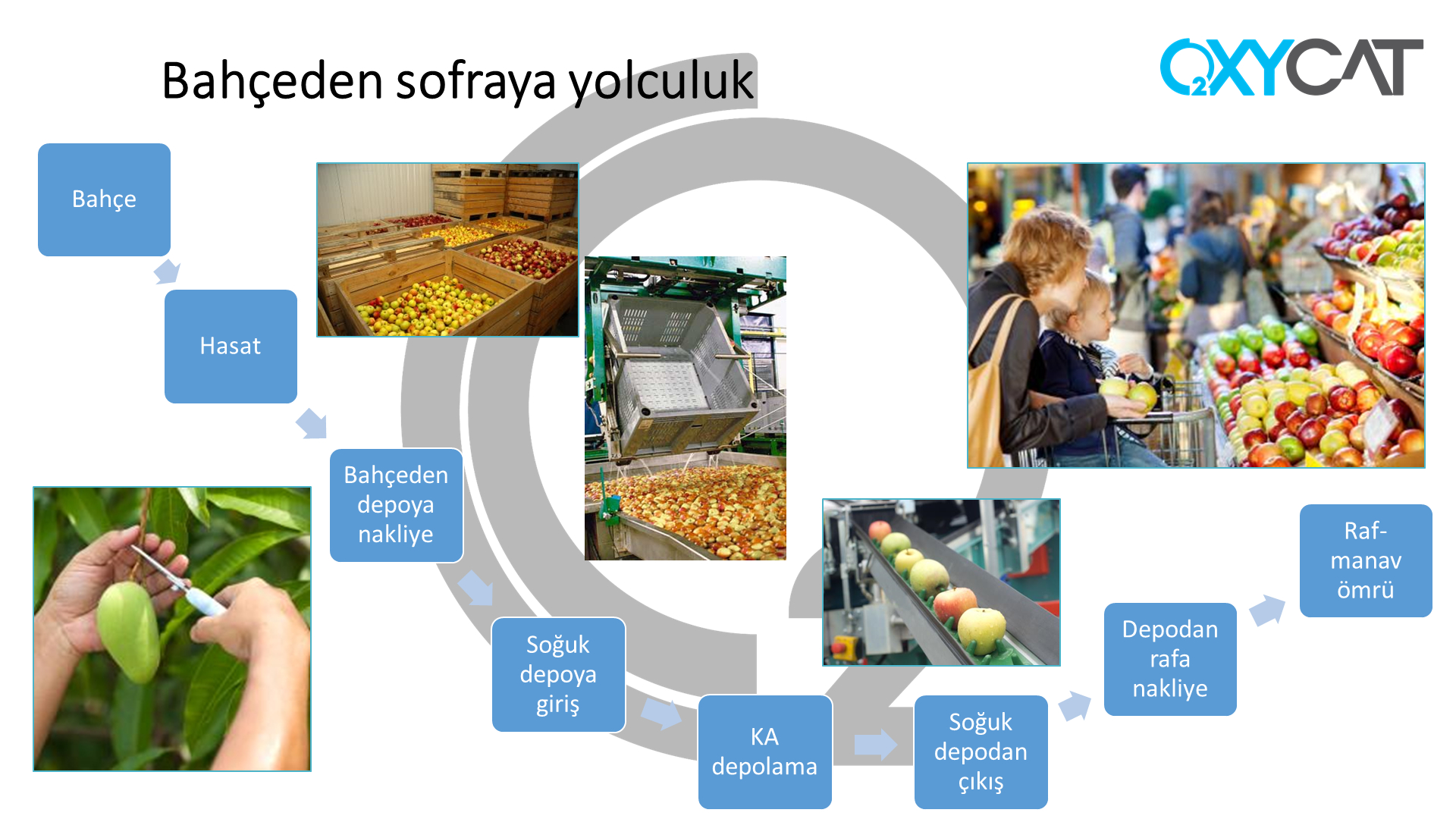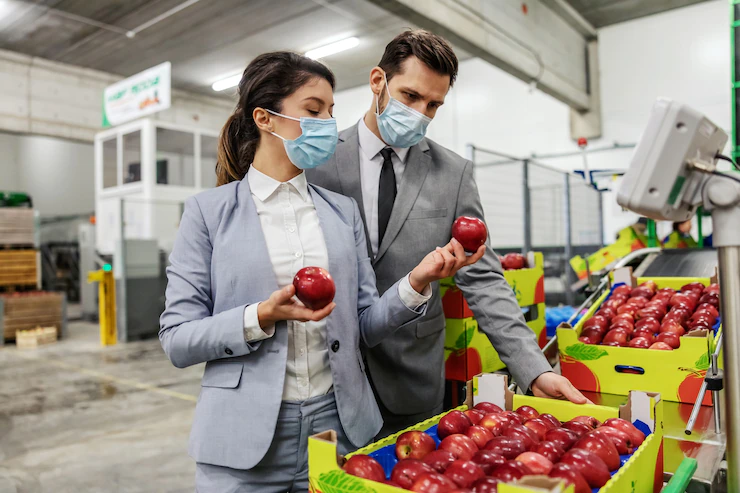Controlled Atmosphere Storage
What is CA? – CA principles – Respiration and Climax
Respiration and Climacteric
CA in Fruit Storage
Quality and Added Value
Controlled Atmosphere Products
What is Controlled Atmosphere (CA)?
Controlled Atmosphere (CA) is an artificially created gas environment in a gastight chamber, where the concentration of gases differs from the natural one. The cooling process with CA system is a storage method when a cooling and CA systems are used together in the same chamber. First, the cooling system cools the chamber down to the core target temperature and then CA system gradually decreases the oxygen (O2) level to a minimum, and keeps the carbon dioxide (CO2) to the maximum level which the fruit can withstand and be stored at. Then, the systems maintain the same level of temperature and gases until the storage period is over and the chamber is open. The composition of gases in the chamber with CA is selected depending on the type of a vegetable or a fruit that will be stored in this storage room, on the storage targets, temperature, relative humidity, and other factors.
Compared to a usual cold store, in a cold store with CA conditions many products can be stored from 2 to 4 times longer periods without losing much of its original quality. Therefore, the CA store has a huge advantage, because the quality and freshness of fruit and vegetables can be preserved without any use of any chemicals. This, in its turn, makes the CA technology one of the most progressive and modern technologies for fruit and vegetables storing. Both in our country and around the world, CA systems are widely used mainly in fruit stores.
The operation of the CA system is ensured by equipment and automation that monitor and adjust the concentration of gases in the air of a gas-tight (hermetic) room.
What are the principles of CA system operation in storage for fresh fruit and vegetables?
The principle behind controlled atmosphere technologies is to reduce the rate of respiration, reduce microbial growth, and slow down enzymatic spoilage by changing the gas environment surrounding the food product. To achieve this result, the CA system provides the following conditions in the room:
- Lowest applicable temperature,
- Lowest applicable O2 concentration,
- Highest applicable CO2 concentration,
- Prevention of moisture loss (relative humidity 90-99%).
Also, cooling stores where CA technology is used must be gastight. Therefore, an important role is played by the quality of the doors to the store chamber, and the quality of the materials used for interface-seal of the panels, so that both of them ensure gas-tightness of the chamber.
If all of the above conditions are met, the CA systems integrated into cooling stores can extend the period of post-harvest storage up to 4 times (depending on the type and variety of fruits) while maintaining all the fruit qualities: brix, firmness, look, taste, a set of vitamins and other elements that are useful and necessary for human health.
Thus, in order to create the right conditions for storing fruit and vegetables with the help of CA, two important components are required: a high-quality CA system that meets the parameters of the room, and the gas-tightness of the room.
Climacteric fruit and breathing (respiration)
What does respiration (breathing) in fruit mean?
After harvesting, fruits continue to live, they breathe, or, in other words, they absorb oxygen and release carbon dioxide.
According to the intensity of respiration, the fruit and vegetables are divided into two groups:
1. Climacteric fruits and vegetables are the fruits and vegetables in which the intensity of respiration increases during the ripening period. This group includes apples, pears, kiwi, bananas, mangoes, avocados and others. After these fruits and vegetables are harvested, they begin to actively breathe and release ethylene intensively. The more the level of ethylene in the storage room is, the more it quickens these fruits and vegetables breathing, which leads, in its turn, to an even faster acceleration of the ripening process, and eventually, over ripening and microbiological deterioration.
2. Non-climacteric fruits and vegetables are those fruits and vegetables in which the intensity of respiration after harvest, on the contrary, slightly decreases or remains approximately the same throughout the entire life period. For example: pomegranate, pineapple or citrus. Such fruits, after harvesting, simply “get old” and deteriorate.
Intense respiration of the harvested fruits leads to a deterioration in their quality (withering, loss of color, loss of weight, etc.). The period of fruit storage, especially climacteric ones, can be increased by reducing the intensity of respiration using the CA system. The protocol for this system is as follows:
– During the first stage, with the help of cooling, the respiration of the fruits slows down.
– During the second stage, to minimize respiration process further, the CA system is activated.
This system lowers the content of oxygen (O2) in the atmosphere of the storage facility. This process slows down the respiration of fruits, decreases the amount of ethylene, reduces the intensity of oxidation processes, and thereby stops the ripening and over-ripening of fruits. The CA system also maintains a certain amount of carbon dioxide (CO2) in the atmosphere of the storage facility. This process also reduces the effect of ethylene, slows down and inhibits various chemical reactions, reduces the development of physiological and fungal diseases, thereby it maintains the quality of the fruits, their hardness and color.
Also, when storing climacteric fruits that are highly sensitive to the presence of ethylene, to eliminate ethylene in the chamber, an Ethylene Burner can be additionally installed in the CA system.
In CA system applications, it is also possible to suppress the development of fruit diseases (fungi / mold) transferred from the orchards. This can be achieved by applying the “storage at the lowest level of oxygen and the highest level of carbon dioxide that the fruit can withstand” protocol. The parameters of this protocol are different for each type of fruit.
The place of Controlled Atmosphere in the Fruit Story
Orchard – Harvest – Transportation to the cold store – Cooling – Controlled Atmosphere – Removal from the cold store – Transportation to the market – Shelf life
After a fruit is harvested it starts its way to your table. In order for a fruit to get to your table in good shape, color and quality, it needs to go through important stages. These stages altogether are called post-harvest fruit story. Each step in the story is crucial and includes many details:
1. The first stage is harvesting. The moment of harvesting is extremely important. A well-grown product suitable for long-term storage should be harvested at the right time, both in terms of the dates and the time of the day. For long –term storage, fruits should be harvested shortly before ripening. Also, they should be collected accurately, without any physical damages.
2. At the second stage, after the fruits are properly harvested and packed, they are transported to the cold store right away without any prevarications and delays. Maximum attention on this stage should be given to not losing time.
3. After the fruits reach the store, the cool chain starts. The cooling system of the store cools the inner core temperature of the fruits to a required level. It slows down the fruits respiration.
4. At the fourth stage, the controlled atmosphere is activated, and long-term storage of the product begins. The fruit will spend the longest time on this stage. And here it is important to note the role and importance of CA in the fruit post-harvest story. When you add the CA system to the post-harvest story, it can extend the storage life of a fruit 2-4 times. For example, while the storage period for apples is 3 to 5 months, with CA system these period can be prolonged to 10-11 months. The CA system not only prolongs the time, but also ensures that the product quality stays almost the same as it was when it entered the cold store.
5. At the fifth stage, when the storage period is over, the CA room is ventilated. And only after the atmospheric conditions reach the normal respirable level, life safety rules are applied to make sure that the room is safe to enter. Only after that, the products can be taken for packaging and shipping.
6. When the process of packing is finished, the products go to the market. Maintaining the cold chain is also important here.
7. The time until the end user makes the purchase is called the shelf life. To prolong the fruit shelf life, it is crucial to maintain the cold chain.
The story does not actually end here, as we all know and have experienced, after end customers buy fruits from the market they keep the fruits in the refrigerator until they consume them.
How CA benefits quality and added value
Essential components for the effective operation of the CA system.
In order for a store with the CA system to meet world standards and bring effective results, it is necessary that the store and all the equipment in it comply with the following standards:
- First of all, the plan for the room loading and cooling must have sufficient capacity and structure to ensure homogeneous cooling of not only the room itself, but also every fruit at every point in the room;
- Gas tightness protocols must be thoroughly followed;
- CA equipment must be correctly selected in terms of the model, its power, oxygen and carbon dioxide scrubbers;
- Reliable industrial automation system for CA must be used;
- In order to create proper CA conditions in the store special CA accessories and added units such as temperature sensors, portable manual gas analyzers, separate aeration units etc. must be used.
Unfortunately, in projects where these components are not properly combined and the requirements are not met, it is difficult or even not possible to achieve successful results.
It is very important that the cooling is done by following the right principles and that the system work is possible to measure and actually is measured.
If all of the above standards are met, then the CA system can bring many additional benefits:
- Products stored with the CA system can be stored for a longer time than the products in conventional cooling stores, while their qualities are almost completely preserved;
- Prevent fruit loss due to rot, fungus, mold, etc. brought from the garden;
- Prevention of moisture loss due to slow fruit respiration;
- Since the products stored with the CA system can be stored longer with maintaining their quality, a price advantage can be achieved when selling the products;
- A significant advantage in case of a logistics problem. By extending the shelf life of goods that are waiting for sale in warehouses, it is possible to provide some level of flexibility in logistics when there are factors such as political or military situations that may impact international logistics.
As a result, controlled atmosphere systems provide many additional benefits for cold storage and quality control.













